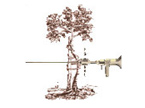1. What is the biceps tendon?
The biceps tendon is a long cord-like structure which is located in the front of the shoulder. It originates from the top of the shoulder socket (the glenoid) and exits the joint through a bony trough (the biceps groove). Below the shoulder, this tendon becomes the long head of the biceps muscle. The short head of the biceps is a continuation of the conjoined tendon which originates from a bony hook (the coracoid) at the front of the shoulder blade. Thus the biceps muscle, which functions to bend the elbow and rotate the forearm, has two anchor points in the shoulder region.
2. Who get biceps tendon injuries?
In general, these injuries occur more frequently as we become older. As we age, our tendons lose their elasticity and slowly become stiffer and more “brittle.” The blood supply which nourishes the tendon also diminishes with age. The “degenerative” processes may be more pronounced in sedentary individuals, but may be lessened with proper and regular exercise. The well conditioned individual, however, is not immune from biceps tendon injuries as over-training can also harm an otherwise healthy tendon.
3. How do biceps tendon injuries occur?
As mentioned above, age, inactivity, or over-activity can weaken a tendon which may lead to injury due to the decreased ability to endure repetitive motions and sudden loads. Because of its location, from a direct blow to the front of the shoulder. Some individuals develop bone spurs in their biceps grooves or under the top of their shoulder blades (the acromion) which can lead to wear and tear of their tendons. A less frequent injury is a dislocation of the biceps tendon from its groove. This is usually seen in combination with a tear of the subscapularis tendon or the rotator cuff tendon which normally help hold the biceps tendon in it groove. The biceps tendon can also be injured at its attachment site on top of the glenoid. This usually involves an avulsion, where the tendon is pulled off the bone and rendered unstable.
4. What happens to the tendon when it is injured?
If the tendon or its sheath (which encases the tendon) is irritated, it becomes inflamed, resulting in pain and swelling. This condition is called “tendinitis.” Mild injuries can also result in microscopic tearing of individual tendon fibers. As the severity of an injury increases, larger tears can occur to the point where the tendon is partially torn or even completely ruptured. If a rupture occurs, the long head will usually fall distally toward the elbow. Biceps muscle function usually remains nearly normal because of its dual attachment proximally.
5. How are biceps tendon injuries treated?
Initially, rest, ice, and gentle anti-inflammatory medications are all that is usually needed. Sometimes an injection with a strong anti-inflammatory medication such as cortisone is needed to control the pain and swelling. Severe cases which fail to improve may require surgical treatment.
6. What does surgery involve?
Surgical treatment depends on the nature and extent of damage to the tendon. If only a small portion of the tendon is damaged, a simple arthroscopic shaving (debridement) of the torn fibers may be all that is needed. If a significant portion is involved, a biceps tenodesis may need to be performed. This is done by arthroscopically removing the torn tendon stump from inside the shoulder joint and then, through a small skin incision, attaching the remaining tendon to the bone in the upper arm (humerus). If the biceps tendon is completely rupture, causing the muscle to bulge in the upper arm, a tenodesis can be done only if the distal portion remains near the top of the shoulder. A tenodesis is not done if the tendon slides too far distally because doing so would require unacceptably large incisions. If the tendon has been partially avulsed from its origin on the top of the glenoid (SLAP lesion), it can be arthroscopically reattached using miniature screws and sutures.
7. What is the usual course after surgery?
A simple sling is all that is needed for the first few weeks after surgery. Immediate use of the hand is encouraged, but only for very light objects. Four to six weeks of healing is required before a gradual return to moderate or heavy lifting. Desk work and light-duty can usually be resumed within the first week or two. Return to heavy labor usually takes 2 to 4 months.


